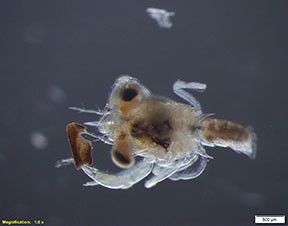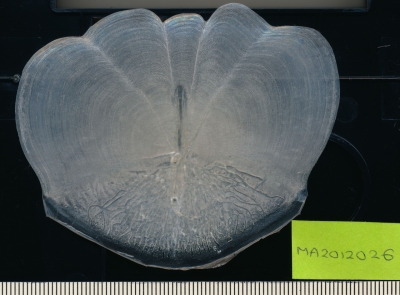 PORT ARANSAS, Texas - The Texas State Aquarium is investing in research at the University of Texas Marine Science Institute (UTMSI) to help understand the movements and migrations of both Atlantic tarpon and larval blue crabs. Both of these animals are important to the sport and commercial fishing economy of the Texas Coast.
PORT ARANSAS, Texas - The Texas State Aquarium is investing in research at the University of Texas Marine Science Institute (UTMSI) to help understand the movements and migrations of both Atlantic tarpon and larval blue crabs. Both of these animals are important to the sport and commercial fishing economy of the Texas Coast.
In fact, Atlantic tarpon is one of Texas’s best known sport fisheries. In the late 1800’s Port Aransas was known as the town of “Tarpon” due to the large number of anglers fishing for tarpon. Since that time, the number of tarpon in our bays have dramatically decreased, although tarpon numbers may be slowly increasing in recent years.
Dr. Benjamin Walther at UTMSI will be conducting research with the support of the Texas State Aquarium to understand the movements and migration habits of this valuable sport fish. This understanding of migration is crucial to the management of the fishery. Dr. Walther’s approach is particularly valuable because it uses the non-lethal collection of scales. The scales contain a wealth of information about the water that the fish move through. When scales are created by the fish, they contain chemical signatures that scientists can use to help figure out how salty the water was when the fish created that scale. This is especially important for Atlantic tarpon who migrate between the salty ocean and less-salty bay systems. 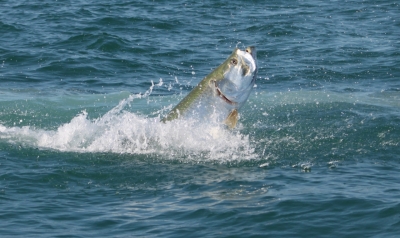
The Texas State Aquarium is collaborating with researchers to provide scales from Atlantic tarpon that have lived at the aquarium for approximately 10 years. Studying the scales from these fish gives researchers a very accurate baseline for the chemistry of the water that those fish were kept in. This step is important for researchers to validate the sampling technique so that they can properly interpret the scales from Atlantic tarpon in the wild. The research team, with the support from Saltwater-fisheries Enhancement Association (SEA), is cooperating with local fishermen and fishing tournaments by distributing waterproof scale collection envelopes that allow anglers to retain and return any scales collected during their trips. The involvement of local anglers as “Citizen Scientists” will provide valuable samples and ensure the continued success of this important project.
This research will help shed light on the well-loved Atlantic tarpon sport fishery. If resource managers understand the movements and migrations of tarpon in our local bays and estuaries they will be able make good decisions that help support healthy tarpon populations. Once this project is successful, the researchers plan to use the developed techniques on other important fishery species such as red drum.
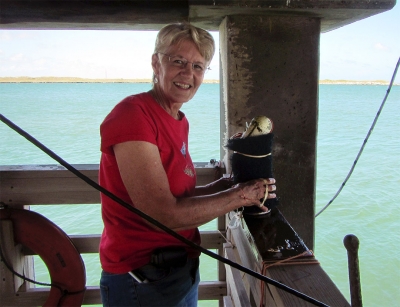 The Texas State aquarium is also providing funding to UTMSI for a citizen science project that will provide insight into the causes of declining blue crab populations in South Texas. Blue crabs support a $12 million dollar commercial fishing industry and are the primary food source for many beloved species, such as the endangered Whooping Crane and red drum. Blue crabs have a complex life cycle and move between the ocean and bay systems. Scientists at UTMSI, led by Dr. Ed Buskey, are interested in better understanding this complexity and what makes the crabs move and migrate. Adult female crabs move from the bays to the open Gulf with large clusters of eggs under their bodies. These eggs hatch into tiny crab larvae that drift with the currents along the coast. When they encounter the passes between the bay and the Gulf, they sense the changes in salinity and chemicals in the water from the bays and wait for incoming tides to sweep them into the bays. While in the bays, the small crab larvae encounter sea grasses and other plants on the bottom which they attach to, and grow into juvenile crabs.
The Texas State aquarium is also providing funding to UTMSI for a citizen science project that will provide insight into the causes of declining blue crab populations in South Texas. Blue crabs support a $12 million dollar commercial fishing industry and are the primary food source for many beloved species, such as the endangered Whooping Crane and red drum. Blue crabs have a complex life cycle and move between the ocean and bay systems. Scientists at UTMSI, led by Dr. Ed Buskey, are interested in better understanding this complexity and what makes the crabs move and migrate. Adult female crabs move from the bays to the open Gulf with large clusters of eggs under their bodies. These eggs hatch into tiny crab larvae that drift with the currents along the coast. When they encounter the passes between the bay and the Gulf, they sense the changes in salinity and chemicals in the water from the bays and wait for incoming tides to sweep them into the bays. While in the bays, the small crab larvae encounter sea grasses and other plants on the bottom which they attach to, and grow into juvenile crabs.
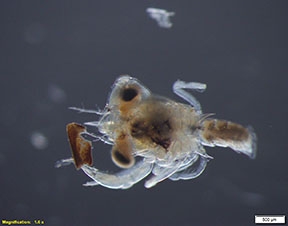 In order to figure out when and where the small crab larvae are going, scientists will put fuzzy traps made with a material similar to air conditioning filter in different parts of our local bays. The fuzzy surface of the traps provide the perfect location for a larval crab to settle and cling to. Volunteers pull up these traps each day, wash off the crab larvae and preserve them so scientists can identify and count them. This allows scientists to know how many blue crab larvae are making their way back into the bay from the Gulf of Mexico. Because of the limited number of local passes between the bays and the Gulf, scientists think that blue crab populations could be declining because there are not enough larval crabs finding their way back into our bays. For example, the reopening of Cedar Bayou will allow more larval blue crabs to enter Mesquite Bay near the Aransas National Wildlife Refuge. This should help increase the populations of blue crabs near the refuge, which are an essential winter food for Whooping Cranes.
In order to figure out when and where the small crab larvae are going, scientists will put fuzzy traps made with a material similar to air conditioning filter in different parts of our local bays. The fuzzy surface of the traps provide the perfect location for a larval crab to settle and cling to. Volunteers pull up these traps each day, wash off the crab larvae and preserve them so scientists can identify and count them. This allows scientists to know how many blue crab larvae are making their way back into the bay from the Gulf of Mexico. Because of the limited number of local passes between the bays and the Gulf, scientists think that blue crab populations could be declining because there are not enough larval crabs finding their way back into our bays. For example, the reopening of Cedar Bayou will allow more larval blue crabs to enter Mesquite Bay near the Aransas National Wildlife Refuge. This should help increase the populations of blue crabs near the refuge, which are an essential winter food for Whooping Cranes.




